- Home
- Timothy Egan
The Worst Hard Time: The Untold Story of Those Who Survived the Great American Dust Bowl Page 2
The Worst Hard Time: The Untold Story of Those Who Survived the Great American Dust Bowl Read online
Page 2
"The principal would call everyone out of class and say, 'Go home! Go home now. And hurry!'"
A Sunday in mid-April 1935 dawned quiet, windless, and bright. In the afternoon, the sky went purple—as if it were sick—and the temperature plunged. People looked northwest and saw a ragged-topped formation on the move, covering the horizon. The air crackled with electricity. Snap. Snap. Snap. Birds screeched and dashed for cover. As the black wall approached, car radios clicked off, overwhelmed by the static. Ignitions shorted out. Waves of sand, like ocean water rising over a ship's prow, swept over roads. Cars went into ditches. A train derailed.
Jeanne Clark had been outside playing when her mother called to her, panic in her voice.
"It was like I was caught in a whirlpool," she says. "All of a sudden it got completely dark. I couldn't see a thing."
That was Black Sunday, April 14, 1935, day of the worst duster of them all. The storm carried twice as much dirt as was dug out of the earth to create the Panama Canal. The canal took seven years to dig; the storm lasted a single afternoon. More than 300,000 tons of Great Plains topsoil was airborne that day. For weeks afterward, eight-year-old Jeanne Clark could not stop coughing. She was taken to the hospital, where dozens of other children, as well as many elderly patients, were spitting up fine particles. The doctor diagnosed Jeanne with dust pneumonia, the brown plague, and said she might not live for long. Jeanne's mother had trouble believing the doctor's words. She had come here for the air, and now her little girl was dying of it.
Down south, at the high western edge of the plains, a wind-bent cowboy feeds a horse in a field near the house he built in Dalhart, Texas. The breeze is up again in the Panhandle, blowing tumbleweeds against a fence, tossing around cottonwood leaves. Melt White walks with the slow, stiff gait of a horseman in his later years.
"Need some rain," he says.
White remembers when the rain merchants came through town in the Dirty Thirties. Dalhart took up a collection and paid a man named Tex Thornton to induce moisture from the sky. The grass was gone by then. Thornton set off his pyrotechnics, dynamiting the sky, just as he promised. Still the dry days dragged on, one white sky after another.
Nearly all the people who Melt White grew up with are gone now. It was in Dalhart that some of the leading citizens of the Texas Panhandle vowed to make a last stand, promising they would never leave town. If nature is out of whack, then we'll fight with everything we got, they said at town meetings. On Sundays, a mob of people with clubs herded rabbits into a corral and smashed their skulls. The skies, for a time, were blotted with great clouds of grasshoppers. To kill the hoppers, the townsfolk mixed a blend of arsenic, molasses, and bran, and spread it over the land, aided by the National Guard. Melt White was sickened by the rabbit drives, the plagues of hoppers, a town of random death and no comfort from the sky. The land was broken.
"God didn't create this land around here to be plowed up," says White. "He created it for Indians and buffalo. Folks raped this land. Raped it bad."
When the dusters blew so hard that even charter members of the Last Man Club started to move away, the White family stayed put. They were stuck, without money or prospects, children underfoot. Bam White got sick and Melt took over some of his father's family raising duties; it was hard. He was a kid with a temper. He got into a lot of fights. The other kids teased him about his skin, which seemed too full of the sun, even in winter. One Sunday, Melt asked visiting relatives how the family came to be. You shush, boy, he was told. Melt kept at it. Finally, an aunt told about the Apache and Cherokee in him. She said he should never tell anybody—keep it inside the family.
"It's a disgrace to be part Indian," he says. "That's what she said."
But from then on, White understood some of the anger inside him. This cowboy was an Indian, and he was not going to leave town. But what if somebody found out his secret?
At its peak, the Dust Bowl covered one hundred million acres. Dusters swept over the northern prairie as well, but the epicenter was the southern plains. An area the size of Pennsylvania was in ruin and on the run. More than a quarter-million people fled the Dust Bowl in the 1930s. Looking around now, it may seem that most people just hurried through the southern plains or left in horror. Not true. John Steinbeck told part of the story, about getting out, moving somewhere green. Those were the Exodusters. But Steinbeck's exiles were from eastern Oklahoma, near Arkansas—mostly tenant farmers ruined by the collapse of the economy. The families in the heart of the black blizzards were further west, in towns like Guymon and Boise City in Oklahoma, or Dalhart and Follett in Texas, or Rolla and Kismet in Kansas. Not much was heard about the people who stayed behind, for lack of money or lack of sense, the people who hunkered down out of loyalty or stubbornness, who believed in tomorrow because it was all they had in the bank. Yet most people living in the center of the Dust Bowl, about two thirds of the population in 1930, never left during that hard decade.
It was a lost world then; it is a lost world now. The government treats it like throwaway land, the place where Indians were betrayed, where Japanese Americans were forced into internment camps during World War II, where German POWs were imprisoned. The only growth industries now are pigs and prisons. Over the last half-century, towns have collapsed and entire counties have been all but abandoned to the old and the dying. Hurricanes that buried city blocks farther south, tornadoes that knocked down everything in their paths, grassfires that burned from one horizon to the other—all have come and gone through the southern plains. But nothing has matched the black blizzards. American meteorologists rated the Dust Bowl the number one weather event of the twentieth century. And as they go over the scars of the land, historians say it was the nation's worst prolonged environmental disaster.
"In no other instance was there greater or more sustained damage to the American land," the historian Donald Worster wrote.
Afterward, some farmers got religion: they treated the land with greater respect, forming soil conservation districts, restoring some of the grass, and vowing never to repeat the mistakes that led to the collapse of the natural world around them and the death of the children breathing its air. Many of the promises lasted barely a generation, and by the time the global farm commodities era was at hand, the Dust Bowl was a distant war, forgotten in a new rush to spin gold from straw.
For now, the narrative of those times is not just buried among the fence posts and mummified homesteads. People who lived through the whole thing—the great town-building, farm-fattening, family establishing prosperity of the 1920s, followed by the back hand of nature in the next decade, when all of life played out as if filmed in grainy black-and-white—are with us still, shelters of living memory. But before the last witnesses fade away, they have a story to tell.
I PROMISE
The Great Plowup 1901–1930
1. The Wanderer
THEY HAD BEEN on the road for six days, a clan of five bouncing along in a tired wagon, when Bam White woke to some bad news. One of his horses was dead. It was the nineteenth-century equivalent of a flat tire, except this was the winter of 1926. The Whites had no money. They were moving from the high desert chill of Las Animas, Colorado, to Littlefield, Texas, south of Amarillo, to start anew. Bam White was a ranch hand, a lover of horses and empty skies, at a time when the cowboy was becoming a museum piece in Texas and an icon in Hollywood. Within a year, Charles Lindbergh would cross the ocean in his monoplane, and a white man in blackface would speak from the screen of a motion picture show. The great ranches had been fenced, platted, subdivided, upturned, and were going out to city builders, oil drillers, and sodbusters. The least-populated part of Texas was open for business and riding high in the Roaring Twenties. Overnight, new towns were rising, bustling with banks, opera houses, electric streetlights, and restaurants serving seafood sent by train from Galveston. With his handlebar mustache, bowlegs, and raisin-skinned face, Bam White was a man high-centered in the wrong century. The plan was to get to Littlefield,
where the winters were not as bad as Colorado, and see if one of the new fancy-pantsers might need a ranch hand with a quick mind. Word was, a family could always pick cotton as well.
Now they were stuck in No Man's Land, a long strip of geographic afterthought in the far western end of the Oklahoma Panhandle, just a sneeze from Texas. After sunrise, Bam White had a talk with his remaining horses. He checked their hooves, which were worn and uneven, and looked into their eyes, trying to find a measure of his animals. They felt bony to the touch, emaciated by the march south and dwindling rations of feed. The family was not yet halfway into their exodus. Ahead were 209 miles of road over the high, dry roof of Texas, across the Canadian river, bypassing dozens of budding Panhandle hamlets: Wildorado, Lazbuddie, Flagg, Earth, Circle, Mule-shoe, Progress, Circle Back.
If you all can give me another two or three days, White told his horses, we'll rest you good. Get me to Amarillo, at least.
Bam's wife, Lizzie, hated the feel of No Man's Land. The chill, hurried along by the wind, made it impossible to stay warm. The land was so threadbare. It was here that the Great Plains tilted, barely susceptible to most eyes, rising to nearly a mile above sea level at the western edge. The family considered dumping the organ, their prized possession. They could sell it in Boise City and make just enough to pick up another horse. They asked around: ten dollars was the going rate for an heirloom organ—not enough to buy a horse. Anyway, Bam White could not bring himself to give it up. Some of the best memories, through the hardest of years, came with music pumped from that box. They would push on to Texas, twenty miles away, moving a lot slower. After burying their dead horse, they headed south.
Through No Man's Land, the family wheeled past fields that had just been turned, the grass upside down. People in sputtering cars roared by, honking, hooting at the cowboy family in the horse-drawn wagon, churning up dust in their faces. The children kept asking if they were getting any closer to Texas and if it would look different from this long strip of Oklahoma. They seldom saw a tree in Cimarron County. There wasn't even grass for the horse team; the sod that hadn't been turned was frozen and brown. Windmills broke the plain, next to dugouts and sod houses and still-forming villages. Resting for a long spell at midday, the children played around a buffalo wallow, the ground mashed. Cimarron is a Mexican hybrid word, descended from the Apache who spent many nights in these same buffalo wallows. It means "wanderer."
A few miles to the southeast, archaeologists were just starting to sort through a lost village, a place where natives, seven hundred years earlier, built a small urban complex near the Canadian River, the only reliable running water in the region. People had lived there for nearly two centuries and left only a few cryptic clues as to how they survived. When Francisco Vasquez de Coronado marched through the High Plains in 1541, trailing cattle, soldiers, and priests in pursuit of precious metals, he found only a handful of villages along the Arkansas River, the homes made of intertwined grass, and certainly no cities of gold as he was expecting. His entrada was a bust. Indians on foot passed through, following bison. Some of Bam White's distant forefathers—the Querechos, ancestors of the Apache—may have been among them. The Spanish brought horses, which had the same effect on the Plains Indian economy as railroads did on Anglo villages in the Midwest. The tribes grew bigger and more powerful, and were able to travel vast distances to hunt and trade. For most of the 1700s, the Apache dominated the Panhandle. Then came the Comanche, the Lords of the Plains. They migrated out of eastern Wyoming, Shoshone people who had lived in the upper Platte River drainage. With horses, the Comanche moved south, hunting and raiding over a huge swath of the southern plains, parts of present-day Kansas, Colorado, Oklahoma, Texas, and New Mexico. At their peak in the mid-1700s, they numbered about twenty thousand. To the few whites who saw them in the days before homesteading, the Comanche looked like they sprang fully formed from the prairie grass.
"They are the most extraordinary horsemen that I have seen yet in all my travels," said the artist George Catlin, who accompanied the cavalry on a reconnaissance mission to the southern plains in 1834.
The Comanche were polygamous, which pleased many a fur trader adopted into the tribe. Naked, a Comanche woman was a mural unto herself, with a range of narrative tattoos all over her body. From afar, the Indians communicated with hand signals, part of a sign language developed to get around the wind's theft of their shouts. The Comanche bred horses and mules—the most reliable currency of the 1800s—and traded them with California-bound gold-seekers and Santa Fe-bound merchants. In between, they fought Texans. The Comanche hated Texans more than any other group of people.
Starting around 1840, the Texas Rangers were organized by the Republic of Texas to go after the Indians. A mounted Comanche was the most effective warrior of the plains. The Comanche were difficult targets but even better on offense. Years of hunting bison from horses at full speed gave them skills that made for an initial advantage over the Rangers. Once engaged in battle, they charged with a great, rhythmic whoop—like a football cheer. After a raid and some rest, they would charge again, this time wearing their stolen booty, even women's dresses and bonnets. They were proud after killing Texans.
"They made sorrow come into our camps, and we went out like buffalo bulls when the cows are attacked," said Comanche leader Ten Bears in 1867. "When we found them we killed them, and their scalps hang in our lodges. The white women cried, and our women laughed. The Comanches are not weak and blind like the pups of a dog when seven sleeps old."
The Comanche buried their dead soldiers on a hill, if they could find one, and then killed the warriors' horses as well. Bison gave them just about everything they needed: clothes, shelter, tools, and of course a protein source that could be dried, smoked, and stewed. Some tepees required twenty bison skins, stretched and stitched together, and weighed 250 pounds, which was light enough to be portable. The animal stomachs were dried and used as food containers or water holders. Even tendons were put to good use, as bowstrings. To supplement the diet, there were wild plums, grapes, and currants growing in spring-fed creases of the flatland, and antelope, sage grouse, wild turkeys, and prairie chickens, though many Comanche thought it was unclean to eat a bird.
The tribe had an agreement signed by the president of the United States and ratified by Congress, the Medicine Lodge Treaty of 1867, which promised the Comanche, Kiowa, Kiowa-Apache, and other tribes hunting rights to much of the Great American Desert, the area south of the Arkansas River. At the time, there was no more disparaged piece of ground in the coast-to-coast vision of manifest destiny. The nesters and sodbusters pouring into the post-Civil War West could have the wetter parts of the plains, east of the one-hundredth meridian and beyond the Texas Caprock Escarpment. To the Indians would go the land that nobody wanted: the arid grasslands in the west. Early on, Comanchero traders called the heart of this area "el Llano Estacado"—the Staked Plains. It got its name because it was so flat and featureless that people drove stakes into the ground to provide guidance; otherwise, a person could get lost in the eternity of flat. The Staked Plains were reserved for the natives who hunted bison.
At the treaty signing, Ten Bears tried to explain why Indians could love the High Plains.
"I was born upon the prairie where the wind blew free, and there was nothing to break the light of the sun. I was born where there were no enclosures, and where everything drew free breath. I want to die there, and not within walls ... The white man has taken the country we loved and we only wish to wander on the prairie until we die."
Within a few years of the signing, Anglo hunters invaded the treaty land. They killed bison by the millions, stockpiling hides and horns for a lucrative trade back east. Seven million pounds of bison tongues were shipped out of Dodge City, Kansas, in a single two-year period, 1872–1873, a time when one government agent estimated the killing at twenty-five million. Bones, bleaching in the sun in great piles at railroad terminals, were used for fertilizer, selling for up to ten dolla
rs a ton. Among the gluttons for killing was a professional buffalo hunter named Tom Nixon, who said he had once killed 120 animals in forty minutes.
Texans ignored the Medicine Lodge Treaty outright, saying Texas land belonged to Texans, dating to the days of the Republic, and could not be offered up as part of the American public domain. With the bison diminishing, the Indians went after Anglo stock herds. Led by Quanah Parker and other leaders, the Comanche also attacked the trading post at Adobe Walls, just north of the Canadian River. Parker was regal-looking and charismatic, with soft features that made him appear almost feminine. His first name meant Sweet Smell, which is believed to have come from his mother, a Texan kidnapped at age nine and raised as a Comanche. She married into the tribe and raised three children, including Sweet Smell. After Cynthia Parker had lived twenty-four years as an Indian, the Texas Rangers kidnapped her back and killed her husband, Chief Peta Nocona. She begged to be returned to the Indians, but the Rangers would not let her go home.
The Red River War of 1874–1875 broke the Comanche. In one battle, in Palo Duro Canyon, six Army columns descended on an Indian encampment, catching them by surprise. The natives fled. The Army slaughtered 1,048 horses, leaving the Lords of the Plains without their mounts for the remainder of the war. On foot and starving, they were no match for General Philip Sheridan and his industrial-age weaponry. The natives were sent to various camps in the Indian Territory of Oklahoma, and some of their leaders were imprisoned in Florida. In his later years, Sweet Smell married seven women and built a large house. He founded a native religion based on vision quests through the hallucinogens peyote and mescal, a practice the Supreme Court ultimately upheld as a protected form of worship. The last bison were killed within five years after the Comanche Nation was routed and moved off the Llano Estacado. Just a few years earlier, there had been bison herds that covered fifty square miles. Bison were the Indians' commissary, and the remnants of the great southern herd had been run off the ground, every one of them, as a way to ensure that no Indian would ever wander the Texas Panhandle.

 The Immortal Irishman
The Immortal Irishman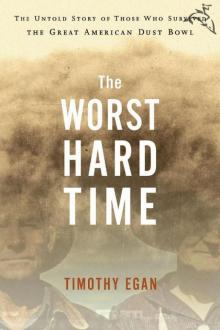 The Worst Hard Time: The Untold Story of Those Who Survived the Great American Dust Bowl
The Worst Hard Time: The Untold Story of Those Who Survived the Great American Dust Bowl The Good Rain: Across Time & Terrain in the Pacific Northwest
The Good Rain: Across Time & Terrain in the Pacific Northwest Breaking Blue
Breaking Blue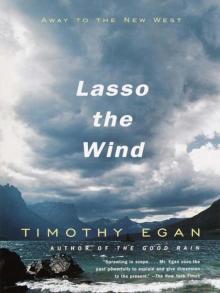 Lasso the Wind: Away to the New West
Lasso the Wind: Away to the New West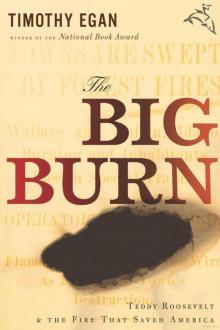 The Big Burn: Teddy Roosevelt and the Fire That Saved America
The Big Burn: Teddy Roosevelt and the Fire That Saved America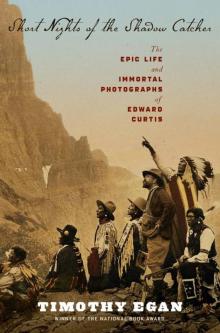 Short Nights of the Shadow Catcher
Short Nights of the Shadow Catcher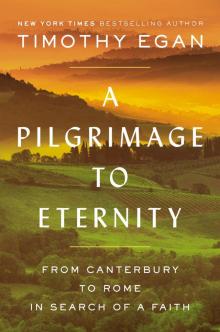 A Pilgrimage to Eternity
A Pilgrimage to Eternity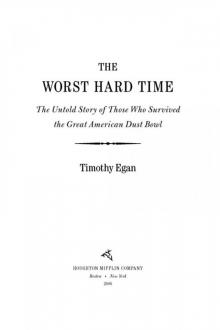 The Worst Hard Time
The Worst Hard Time The Big Burn
The Big Burn